High Performance Culture: Performance Management Approaches
VerifiedAdded on 2023/06/13
|17
|4881
|309
Report
AI Summary
This report delves into individual, team, and organizational development within the context of J. Sainsbury's PLC, a major UK retailer. It analyzes the skills, behaviors, attributes, and knowledge required of HR professionals, including curiosity, decision-making, influence, collaboration, and performance-driven approaches. A self-evaluation identifies areas for personal development, such as communication, leadership, problem-solving, and technological skills. The report also explores factors to consider when implementing learning and development initiatives for sustainable business performance, highlighting the importance of continuous professional development and the learning cycle theory. Furthermore, it examines the contribution of high-performance working (HPW) to employee engagement and competitive advantage, and assesses methods in which performance management, collaborative working, and effective communication can support a high-performance culture and commitment. The report concludes by evaluating different performance management approaches and their effectiveness in fostering a high-performance environment.
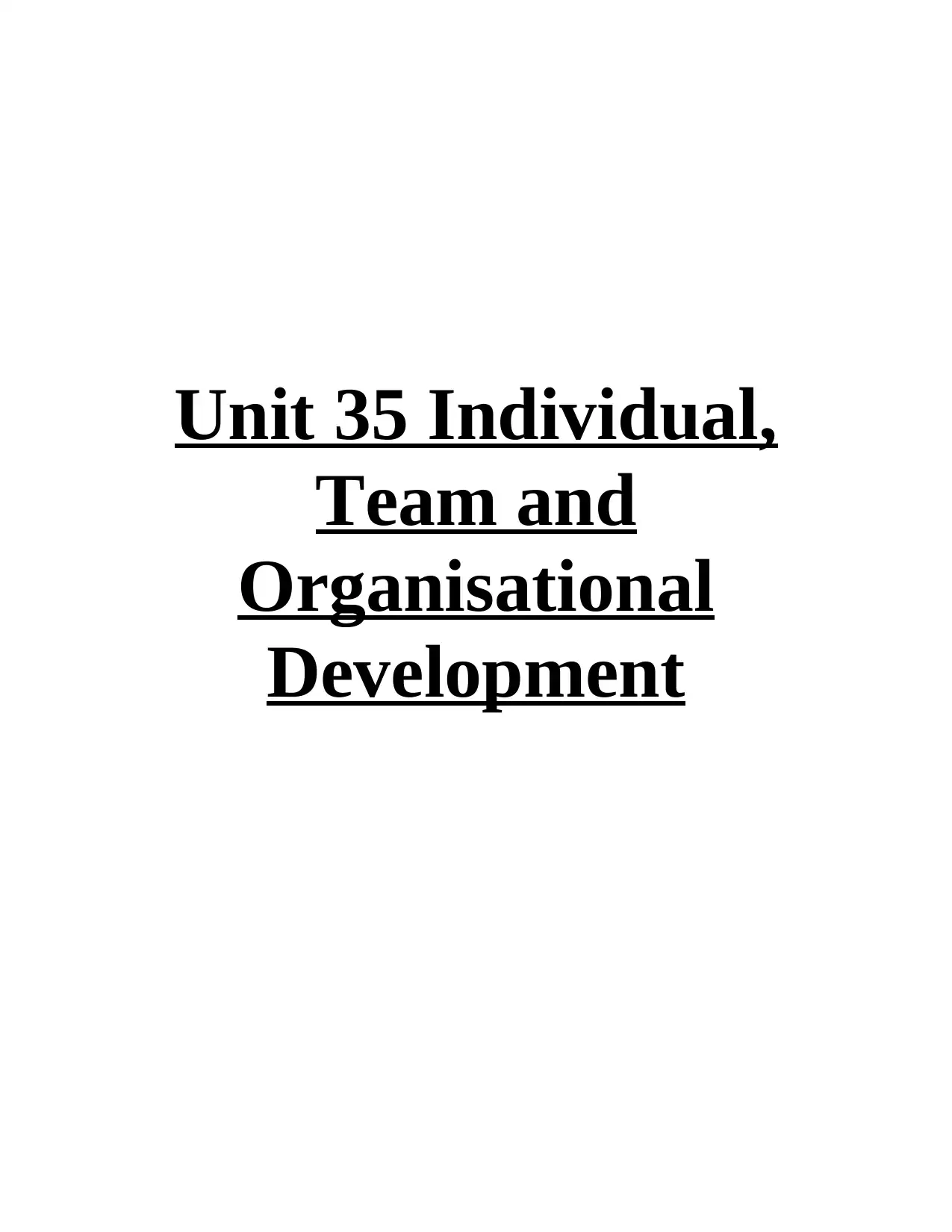
Unit 35 Individual,
Team and
Organisational
Development
Team and
Organisational
Development
Paraphrase This Document
Need a fresh take? Get an instant paraphrase of this document with our AI Paraphraser
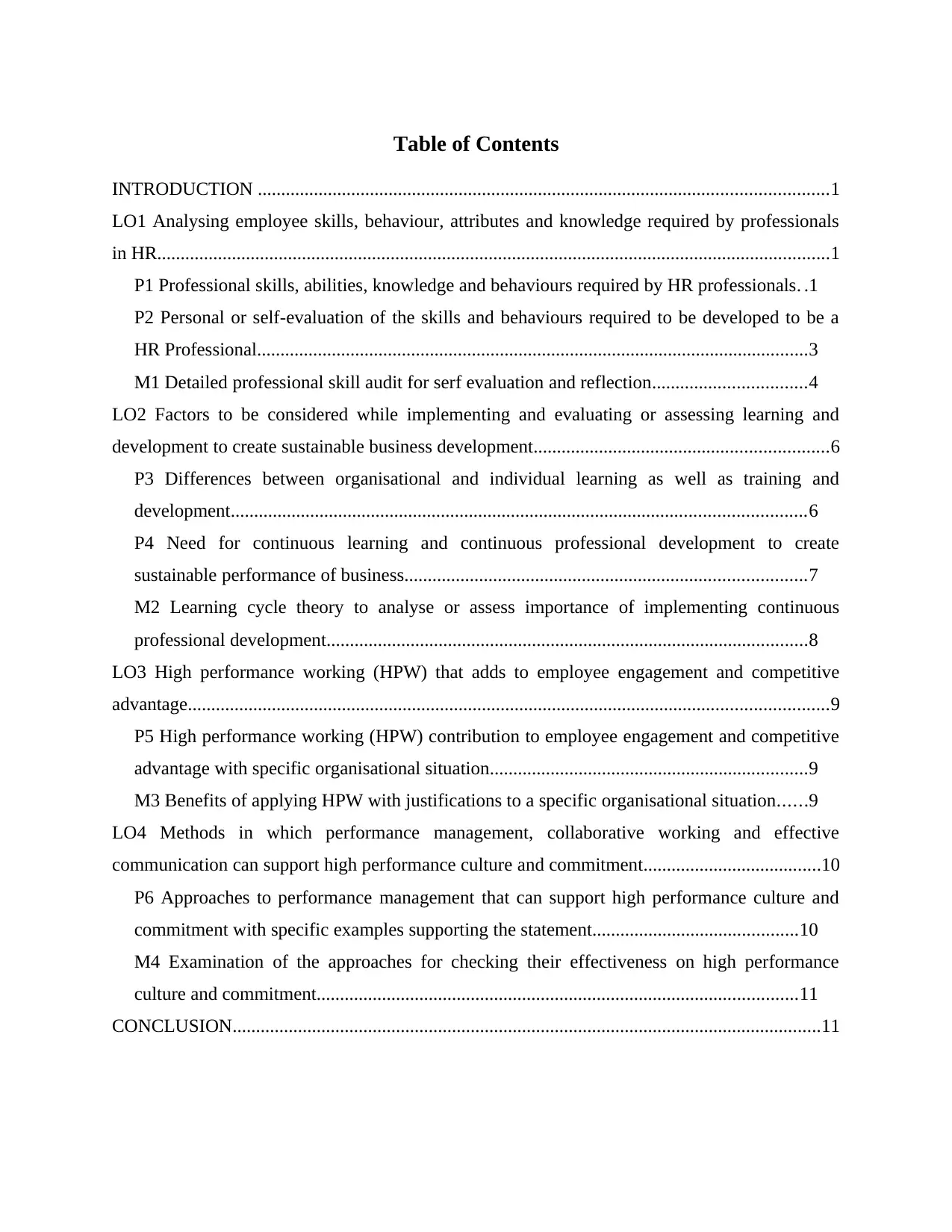
Table of Contents
INTRODUCTION ..........................................................................................................................1
LO1 Analysing employee skills, behaviour, attributes and knowledge required by professionals
in HR................................................................................................................................................1
P1 Professional skills, abilities, knowledge and behaviours required by HR professionals. .1
P2 Personal or self-evaluation of the skills and behaviours required to be developed to be a
HR Professional......................................................................................................................3
M1 Detailed professional skill audit for serf evaluation and reflection.................................4
LO2 Factors to be considered while implementing and evaluating or assessing learning and
development to create sustainable business development...............................................................6
P3 Differences between organisational and individual learning as well as training and
development...........................................................................................................................6
P4 Need for continuous learning and continuous professional development to create
sustainable performance of business......................................................................................7
M2 Learning cycle theory to analyse or assess importance of implementing continuous
professional development.......................................................................................................8
LO3 High performance working (HPW) that adds to employee engagement and competitive
advantage.........................................................................................................................................9
P5 High performance working (HPW) contribution to employee engagement and competitive
advantage with specific organisational situation....................................................................9
M3 Benefits of applying HPW with justifications to a specific organisational situation......9
LO4 Methods in which performance management, collaborative working and effective
communication can support high performance culture and commitment......................................10
P6 Approaches to performance management that can support high performance culture and
commitment with specific examples supporting the statement............................................10
M4 Examination of the approaches for checking their effectiveness on high performance
culture and commitment.......................................................................................................11
CONCLUSION..............................................................................................................................11
INTRODUCTION ..........................................................................................................................1
LO1 Analysing employee skills, behaviour, attributes and knowledge required by professionals
in HR................................................................................................................................................1
P1 Professional skills, abilities, knowledge and behaviours required by HR professionals. .1
P2 Personal or self-evaluation of the skills and behaviours required to be developed to be a
HR Professional......................................................................................................................3
M1 Detailed professional skill audit for serf evaluation and reflection.................................4
LO2 Factors to be considered while implementing and evaluating or assessing learning and
development to create sustainable business development...............................................................6
P3 Differences between organisational and individual learning as well as training and
development...........................................................................................................................6
P4 Need for continuous learning and continuous professional development to create
sustainable performance of business......................................................................................7
M2 Learning cycle theory to analyse or assess importance of implementing continuous
professional development.......................................................................................................8
LO3 High performance working (HPW) that adds to employee engagement and competitive
advantage.........................................................................................................................................9
P5 High performance working (HPW) contribution to employee engagement and competitive
advantage with specific organisational situation....................................................................9
M3 Benefits of applying HPW with justifications to a specific organisational situation......9
LO4 Methods in which performance management, collaborative working and effective
communication can support high performance culture and commitment......................................10
P6 Approaches to performance management that can support high performance culture and
commitment with specific examples supporting the statement............................................10
M4 Examination of the approaches for checking their effectiveness on high performance
culture and commitment.......................................................................................................11
CONCLUSION..............................................................................................................................11
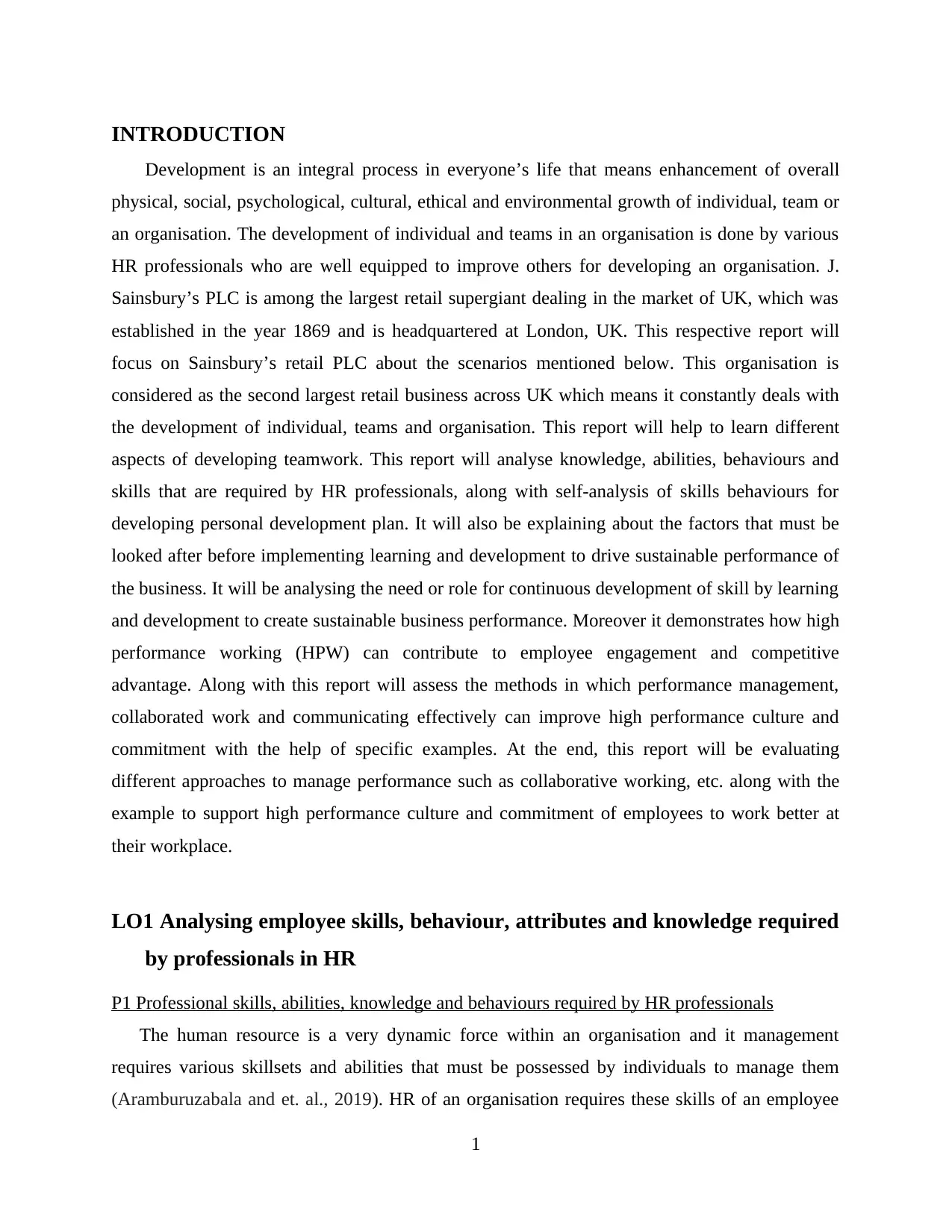
INTRODUCTION
Development is an integral process in everyone’s life that means enhancement of overall
physical, social, psychological, cultural, ethical and environmental growth of individual, team or
an organisation. The development of individual and teams in an organisation is done by various
HR professionals who are well equipped to improve others for developing an organisation. J.
Sainsbury’s PLC is among the largest retail supergiant dealing in the market of UK, which was
established in the year 1869 and is headquartered at London, UK. This respective report will
focus on Sainsbury’s retail PLC about the scenarios mentioned below. This organisation is
considered as the second largest retail business across UK which means it constantly deals with
the development of individual, teams and organisation. This report will help to learn different
aspects of developing teamwork. This report will analyse knowledge, abilities, behaviours and
skills that are required by HR professionals, along with self-analysis of skills behaviours for
developing personal development plan. It will also be explaining about the factors that must be
looked after before implementing learning and development to drive sustainable performance of
the business. It will be analysing the need or role for continuous development of skill by learning
and development to create sustainable business performance. Moreover it demonstrates how high
performance working (HPW) can contribute to employee engagement and competitive
advantage. Along with this report will assess the methods in which performance management,
collaborated work and communicating effectively can improve high performance culture and
commitment with the help of specific examples. At the end, this report will be evaluating
different approaches to manage performance such as collaborative working, etc. along with the
example to support high performance culture and commitment of employees to work better at
their workplace.
LO1 Analysing employee skills, behaviour, attributes and knowledge required
by professionals in HR
P1 Professional skills, abilities, knowledge and behaviours required by HR professionals
The human resource is a very dynamic force within an organisation and it management
requires various skillsets and abilities that must be possessed by individuals to manage them
(Aramburuzabala and et. al., 2019). HR of an organisation requires these skills of an employee
1
Development is an integral process in everyone’s life that means enhancement of overall
physical, social, psychological, cultural, ethical and environmental growth of individual, team or
an organisation. The development of individual and teams in an organisation is done by various
HR professionals who are well equipped to improve others for developing an organisation. J.
Sainsbury’s PLC is among the largest retail supergiant dealing in the market of UK, which was
established in the year 1869 and is headquartered at London, UK. This respective report will
focus on Sainsbury’s retail PLC about the scenarios mentioned below. This organisation is
considered as the second largest retail business across UK which means it constantly deals with
the development of individual, teams and organisation. This report will help to learn different
aspects of developing teamwork. This report will analyse knowledge, abilities, behaviours and
skills that are required by HR professionals, along with self-analysis of skills behaviours for
developing personal development plan. It will also be explaining about the factors that must be
looked after before implementing learning and development to drive sustainable performance of
the business. It will be analysing the need or role for continuous development of skill by learning
and development to create sustainable business performance. Moreover it demonstrates how high
performance working (HPW) can contribute to employee engagement and competitive
advantage. Along with this report will assess the methods in which performance management,
collaborated work and communicating effectively can improve high performance culture and
commitment with the help of specific examples. At the end, this report will be evaluating
different approaches to manage performance such as collaborative working, etc. along with the
example to support high performance culture and commitment of employees to work better at
their workplace.
LO1 Analysing employee skills, behaviour, attributes and knowledge required
by professionals in HR
P1 Professional skills, abilities, knowledge and behaviours required by HR professionals
The human resource is a very dynamic force within an organisation and it management
requires various skillsets and abilities that must be possessed by individuals to manage them
(Aramburuzabala and et. al., 2019). HR of an organisation requires these skills of an employee
1
⊘ This is a preview!⊘
Do you want full access?
Subscribe today to unlock all pages.

Trusted by 1+ million students worldwide
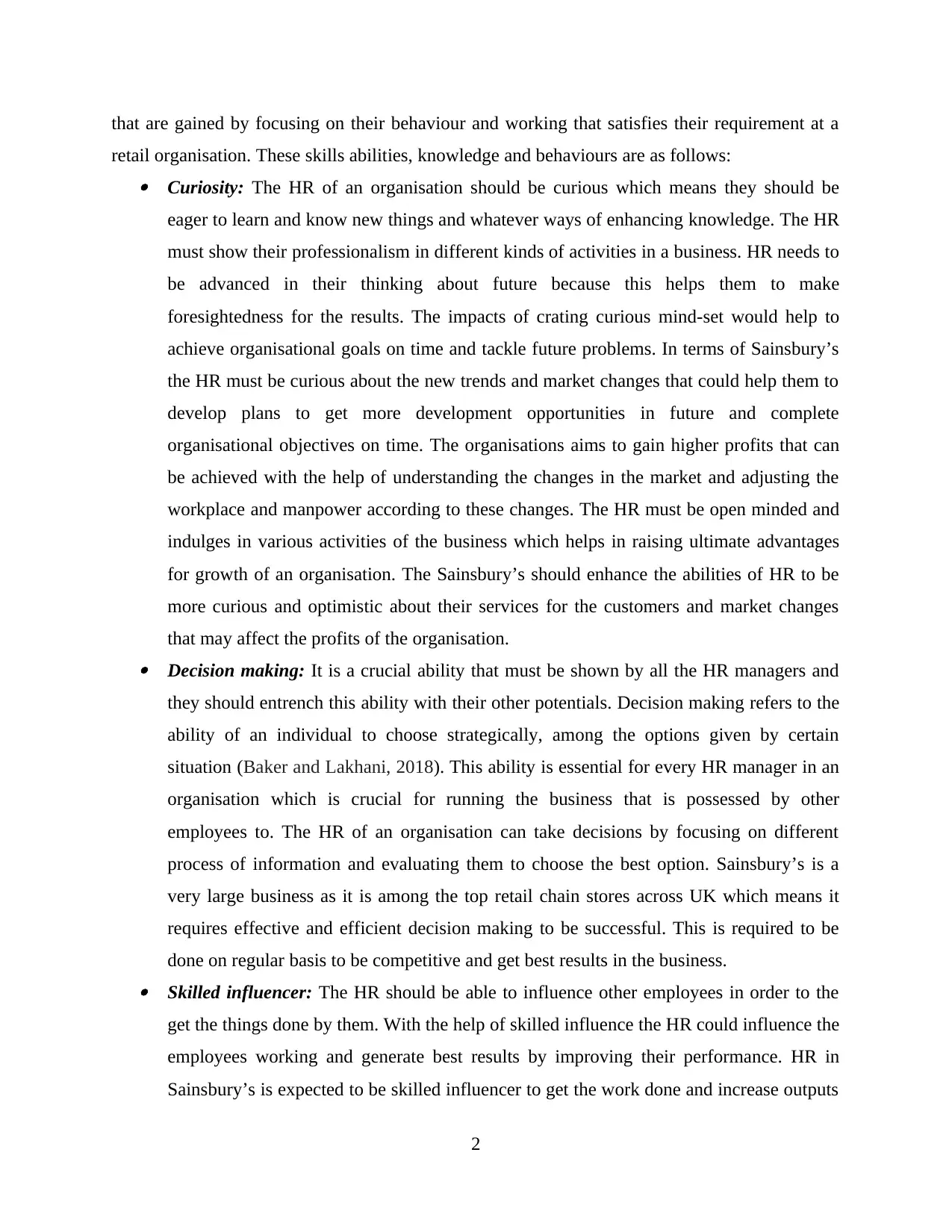
that are gained by focusing on their behaviour and working that satisfies their requirement at a
retail organisation. These skills abilities, knowledge and behaviours are as follows: Curiosity: The HR of an organisation should be curious which means they should be
eager to learn and know new things and whatever ways of enhancing knowledge. The HR
must show their professionalism in different kinds of activities in a business. HR needs to
be advanced in their thinking about future because this helps them to make
foresightedness for the results. The impacts of crating curious mind-set would help to
achieve organisational goals on time and tackle future problems. In terms of Sainsbury’s
the HR must be curious about the new trends and market changes that could help them to
develop plans to get more development opportunities in future and complete
organisational objectives on time. The organisations aims to gain higher profits that can
be achieved with the help of understanding the changes in the market and adjusting the
workplace and manpower according to these changes. The HR must be open minded and
indulges in various activities of the business which helps in raising ultimate advantages
for growth of an organisation. The Sainsbury’s should enhance the abilities of HR to be
more curious and optimistic about their services for the customers and market changes
that may affect the profits of the organisation. Decision making: It is a crucial ability that must be shown by all the HR managers and
they should entrench this ability with their other potentials. Decision making refers to the
ability of an individual to choose strategically, among the options given by certain
situation (Baker and Lakhani, 2018). This ability is essential for every HR manager in an
organisation which is crucial for running the business that is possessed by other
employees to. The HR of an organisation can take decisions by focusing on different
process of information and evaluating them to choose the best option. Sainsbury’s is a
very large business as it is among the top retail chain stores across UK which means it
requires effective and efficient decision making to be successful. This is required to be
done on regular basis to be competitive and get best results in the business. Skilled influencer: The HR should be able to influence other employees in order to the
get the things done by them. With the help of skilled influence the HR could influence the
employees working and generate best results by improving their performance. HR in
Sainsbury’s is expected to be skilled influencer to get the work done and increase outputs
2
retail organisation. These skills abilities, knowledge and behaviours are as follows: Curiosity: The HR of an organisation should be curious which means they should be
eager to learn and know new things and whatever ways of enhancing knowledge. The HR
must show their professionalism in different kinds of activities in a business. HR needs to
be advanced in their thinking about future because this helps them to make
foresightedness for the results. The impacts of crating curious mind-set would help to
achieve organisational goals on time and tackle future problems. In terms of Sainsbury’s
the HR must be curious about the new trends and market changes that could help them to
develop plans to get more development opportunities in future and complete
organisational objectives on time. The organisations aims to gain higher profits that can
be achieved with the help of understanding the changes in the market and adjusting the
workplace and manpower according to these changes. The HR must be open minded and
indulges in various activities of the business which helps in raising ultimate advantages
for growth of an organisation. The Sainsbury’s should enhance the abilities of HR to be
more curious and optimistic about their services for the customers and market changes
that may affect the profits of the organisation. Decision making: It is a crucial ability that must be shown by all the HR managers and
they should entrench this ability with their other potentials. Decision making refers to the
ability of an individual to choose strategically, among the options given by certain
situation (Baker and Lakhani, 2018). This ability is essential for every HR manager in an
organisation which is crucial for running the business that is possessed by other
employees to. The HR of an organisation can take decisions by focusing on different
process of information and evaluating them to choose the best option. Sainsbury’s is a
very large business as it is among the top retail chain stores across UK which means it
requires effective and efficient decision making to be successful. This is required to be
done on regular basis to be competitive and get best results in the business. Skilled influencer: The HR should be able to influence other employees in order to the
get the things done by them. With the help of skilled influence the HR could influence the
employees working and generate best results by improving their performance. HR in
Sainsbury’s is expected to be skilled influencer to get the work done and increase outputs
2
Paraphrase This Document
Need a fresh take? Get an instant paraphrase of this document with our AI Paraphraser
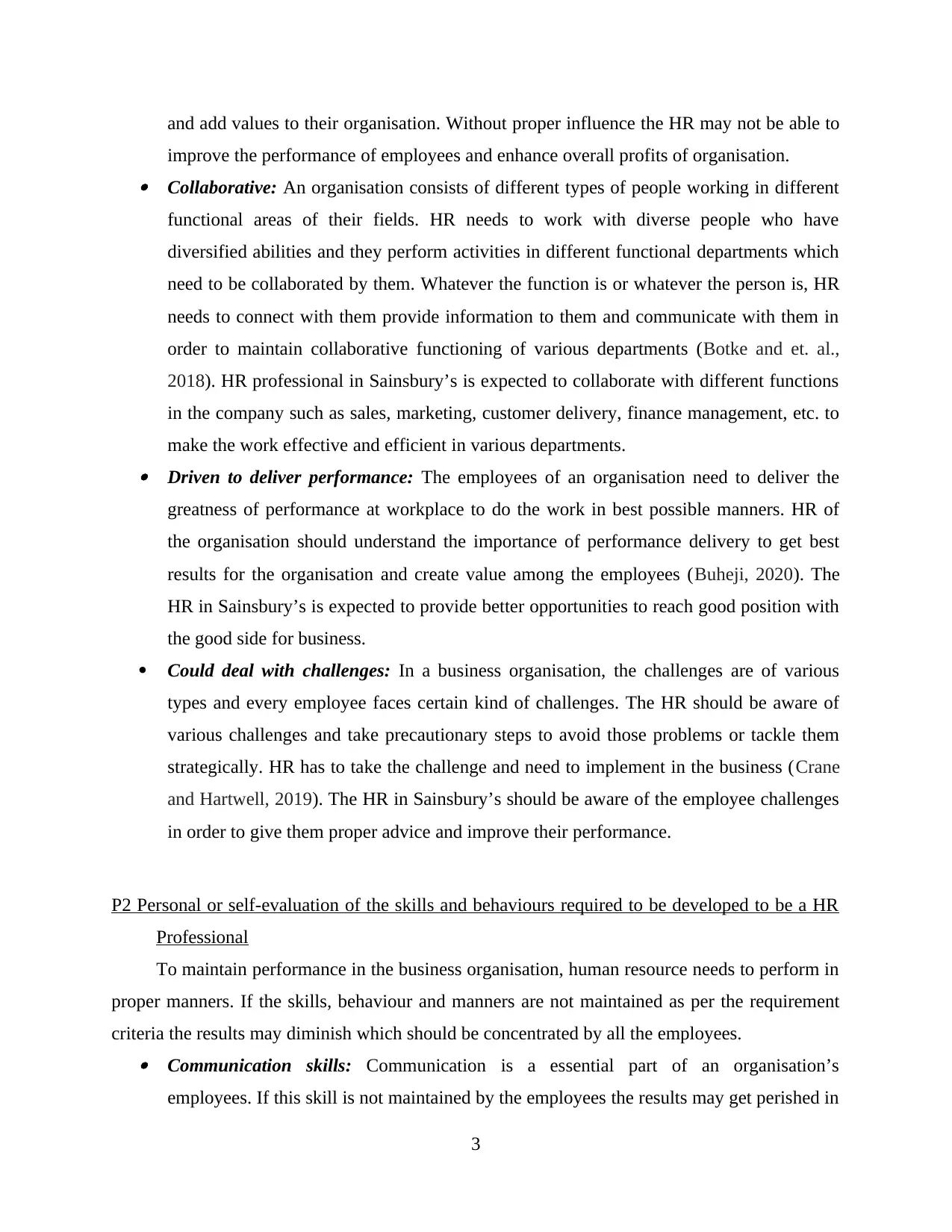
and add values to their organisation. Without proper influence the HR may not be able to
improve the performance of employees and enhance overall profits of organisation. Collaborative: An organisation consists of different types of people working in different
functional areas of their fields. HR needs to work with diverse people who have
diversified abilities and they perform activities in different functional departments which
need to be collaborated by them. Whatever the function is or whatever the person is, HR
needs to connect with them provide information to them and communicate with them in
order to maintain collaborative functioning of various departments (Botke and et. al.,
2018). HR professional in Sainsbury’s is expected to collaborate with different functions
in the company such as sales, marketing, customer delivery, finance management, etc. to
make the work effective and efficient in various departments. Driven to deliver performance: The employees of an organisation need to deliver the
greatness of performance at workplace to do the work in best possible manners. HR of
the organisation should understand the importance of performance delivery to get best
results for the organisation and create value among the employees (Buheji, 2020). The
HR in Sainsbury’s is expected to provide better opportunities to reach good position with
the good side for business.
Could deal with challenges: In a business organisation, the challenges are of various
types and every employee faces certain kind of challenges. The HR should be aware of
various challenges and take precautionary steps to avoid those problems or tackle them
strategically. HR has to take the challenge and need to implement in the business (Crane
and Hartwell, 2019). The HR in Sainsbury’s should be aware of the employee challenges
in order to give them proper advice and improve their performance.
P2 Personal or self-evaluation of the skills and behaviours required to be developed to be a HR
Professional
To maintain performance in the business organisation, human resource needs to perform in
proper manners. If the skills, behaviour and manners are not maintained as per the requirement
criteria the results may diminish which should be concentrated by all the employees. Communication skills: Communication is a essential part of an organisation’s
employees. If this skill is not maintained by the employees the results may get perished in
3
improve the performance of employees and enhance overall profits of organisation. Collaborative: An organisation consists of different types of people working in different
functional areas of their fields. HR needs to work with diverse people who have
diversified abilities and they perform activities in different functional departments which
need to be collaborated by them. Whatever the function is or whatever the person is, HR
needs to connect with them provide information to them and communicate with them in
order to maintain collaborative functioning of various departments (Botke and et. al.,
2018). HR professional in Sainsbury’s is expected to collaborate with different functions
in the company such as sales, marketing, customer delivery, finance management, etc. to
make the work effective and efficient in various departments. Driven to deliver performance: The employees of an organisation need to deliver the
greatness of performance at workplace to do the work in best possible manners. HR of
the organisation should understand the importance of performance delivery to get best
results for the organisation and create value among the employees (Buheji, 2020). The
HR in Sainsbury’s is expected to provide better opportunities to reach good position with
the good side for business.
Could deal with challenges: In a business organisation, the challenges are of various
types and every employee faces certain kind of challenges. The HR should be aware of
various challenges and take precautionary steps to avoid those problems or tackle them
strategically. HR has to take the challenge and need to implement in the business (Crane
and Hartwell, 2019). The HR in Sainsbury’s should be aware of the employee challenges
in order to give them proper advice and improve their performance.
P2 Personal or self-evaluation of the skills and behaviours required to be developed to be a HR
Professional
To maintain performance in the business organisation, human resource needs to perform in
proper manners. If the skills, behaviour and manners are not maintained as per the requirement
criteria the results may diminish which should be concentrated by all the employees. Communication skills: Communication is a essential part of an organisation’s
employees. If this skill is not maintained by the employees the results may get perished in
3
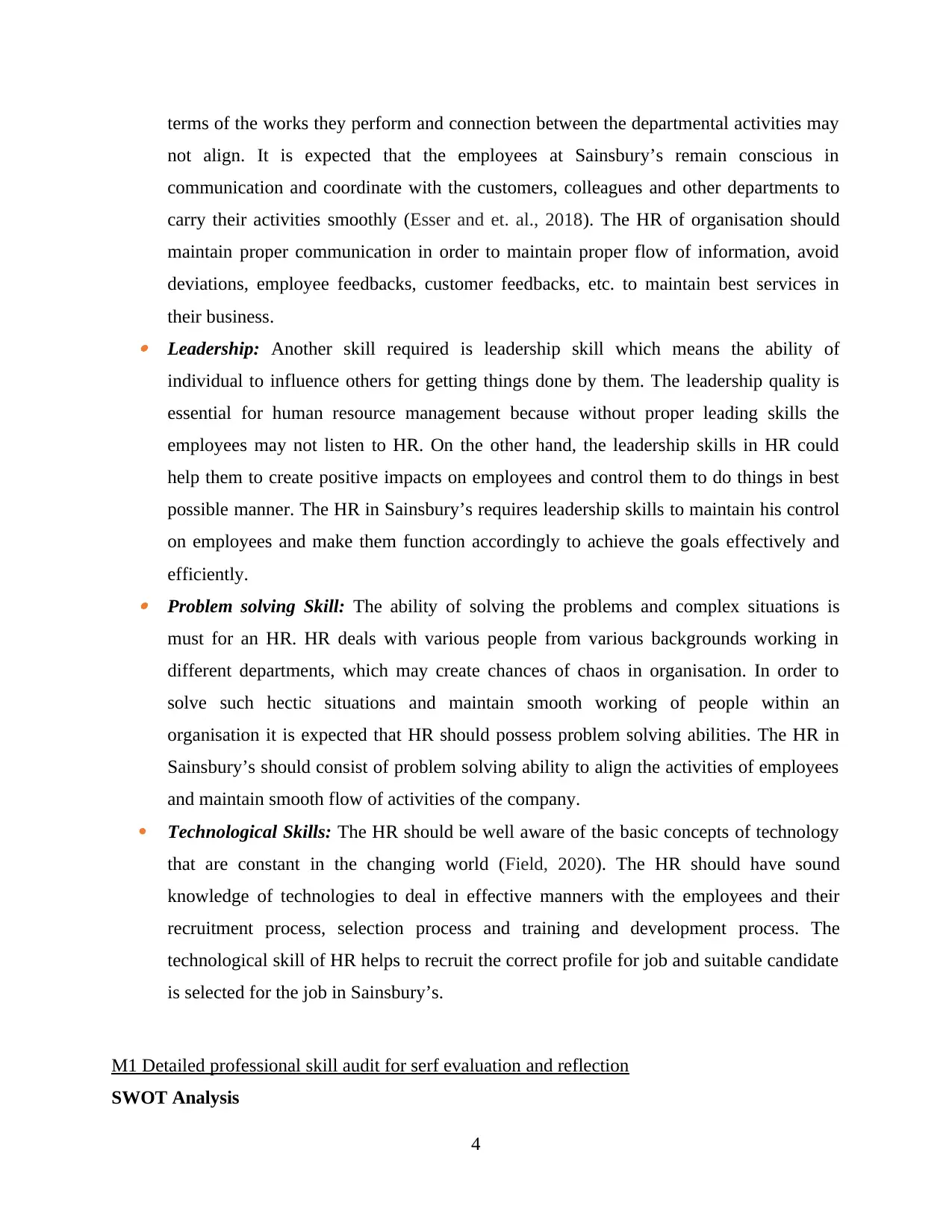
terms of the works they perform and connection between the departmental activities may
not align. It is expected that the employees at Sainsbury’s remain conscious in
communication and coordinate with the customers, colleagues and other departments to
carry their activities smoothly (Esser and et. al., 2018). The HR of organisation should
maintain proper communication in order to maintain proper flow of information, avoid
deviations, employee feedbacks, customer feedbacks, etc. to maintain best services in
their business. Leadership: Another skill required is leadership skill which means the ability of
individual to influence others for getting things done by them. The leadership quality is
essential for human resource management because without proper leading skills the
employees may not listen to HR. On the other hand, the leadership skills in HR could
help them to create positive impacts on employees and control them to do things in best
possible manner. The HR in Sainsbury’s requires leadership skills to maintain his control
on employees and make them function accordingly to achieve the goals effectively and
efficiently. Problem solving Skill: The ability of solving the problems and complex situations is
must for an HR. HR deals with various people from various backgrounds working in
different departments, which may create chances of chaos in organisation. In order to
solve such hectic situations and maintain smooth working of people within an
organisation it is expected that HR should possess problem solving abilities. The HR in
Sainsbury’s should consist of problem solving ability to align the activities of employees
and maintain smooth flow of activities of the company.
Technological Skills: The HR should be well aware of the basic concepts of technology
that are constant in the changing world (Field, 2020). The HR should have sound
knowledge of technologies to deal in effective manners with the employees and their
recruitment process, selection process and training and development process. The
technological skill of HR helps to recruit the correct profile for job and suitable candidate
is selected for the job in Sainsbury’s.
M1 Detailed professional skill audit for serf evaluation and reflection
SWOT Analysis
4
not align. It is expected that the employees at Sainsbury’s remain conscious in
communication and coordinate with the customers, colleagues and other departments to
carry their activities smoothly (Esser and et. al., 2018). The HR of organisation should
maintain proper communication in order to maintain proper flow of information, avoid
deviations, employee feedbacks, customer feedbacks, etc. to maintain best services in
their business. Leadership: Another skill required is leadership skill which means the ability of
individual to influence others for getting things done by them. The leadership quality is
essential for human resource management because without proper leading skills the
employees may not listen to HR. On the other hand, the leadership skills in HR could
help them to create positive impacts on employees and control them to do things in best
possible manner. The HR in Sainsbury’s requires leadership skills to maintain his control
on employees and make them function accordingly to achieve the goals effectively and
efficiently. Problem solving Skill: The ability of solving the problems and complex situations is
must for an HR. HR deals with various people from various backgrounds working in
different departments, which may create chances of chaos in organisation. In order to
solve such hectic situations and maintain smooth working of people within an
organisation it is expected that HR should possess problem solving abilities. The HR in
Sainsbury’s should consist of problem solving ability to align the activities of employees
and maintain smooth flow of activities of the company.
Technological Skills: The HR should be well aware of the basic concepts of technology
that are constant in the changing world (Field, 2020). The HR should have sound
knowledge of technologies to deal in effective manners with the employees and their
recruitment process, selection process and training and development process. The
technological skill of HR helps to recruit the correct profile for job and suitable candidate
is selected for the job in Sainsbury’s.
M1 Detailed professional skill audit for serf evaluation and reflection
SWOT Analysis
4
⊘ This is a preview!⊘
Do you want full access?
Subscribe today to unlock all pages.

Trusted by 1+ million students worldwide
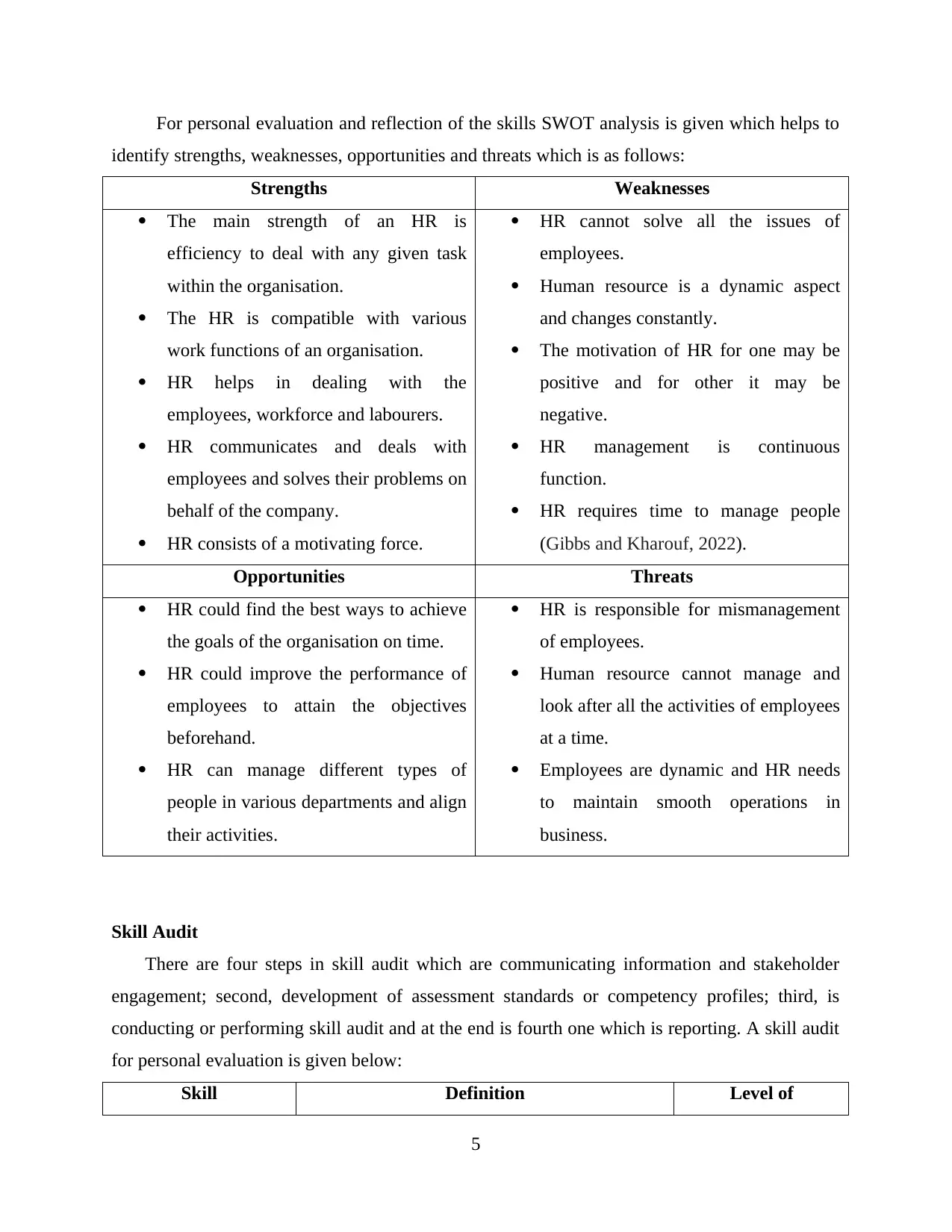
For personal evaluation and reflection of the skills SWOT analysis is given which helps to
identify strengths, weaknesses, opportunities and threats which is as follows:
Strengths Weaknesses
The main strength of an HR is
efficiency to deal with any given task
within the organisation.
The HR is compatible with various
work functions of an organisation.
HR helps in dealing with the
employees, workforce and labourers.
HR communicates and deals with
employees and solves their problems on
behalf of the company.
HR consists of a motivating force.
HR cannot solve all the issues of
employees.
Human resource is a dynamic aspect
and changes constantly.
The motivation of HR for one may be
positive and for other it may be
negative.
HR management is continuous
function.
HR requires time to manage people
(Gibbs and Kharouf, 2022).
Opportunities Threats
HR could find the best ways to achieve
the goals of the organisation on time.
HR could improve the performance of
employees to attain the objectives
beforehand.
HR can manage different types of
people in various departments and align
their activities.
HR is responsible for mismanagement
of employees.
Human resource cannot manage and
look after all the activities of employees
at a time.
Employees are dynamic and HR needs
to maintain smooth operations in
business.
Skill Audit
There are four steps in skill audit which are communicating information and stakeholder
engagement; second, development of assessment standards or competency profiles; third, is
conducting or performing skill audit and at the end is fourth one which is reporting. A skill audit
for personal evaluation is given below:
Skill Definition Level of
5
identify strengths, weaknesses, opportunities and threats which is as follows:
Strengths Weaknesses
The main strength of an HR is
efficiency to deal with any given task
within the organisation.
The HR is compatible with various
work functions of an organisation.
HR helps in dealing with the
employees, workforce and labourers.
HR communicates and deals with
employees and solves their problems on
behalf of the company.
HR consists of a motivating force.
HR cannot solve all the issues of
employees.
Human resource is a dynamic aspect
and changes constantly.
The motivation of HR for one may be
positive and for other it may be
negative.
HR management is continuous
function.
HR requires time to manage people
(Gibbs and Kharouf, 2022).
Opportunities Threats
HR could find the best ways to achieve
the goals of the organisation on time.
HR could improve the performance of
employees to attain the objectives
beforehand.
HR can manage different types of
people in various departments and align
their activities.
HR is responsible for mismanagement
of employees.
Human resource cannot manage and
look after all the activities of employees
at a time.
Employees are dynamic and HR needs
to maintain smooth operations in
business.
Skill Audit
There are four steps in skill audit which are communicating information and stakeholder
engagement; second, development of assessment standards or competency profiles; third, is
conducting or performing skill audit and at the end is fourth one which is reporting. A skill audit
for personal evaluation is given below:
Skill Definition Level of
5
Paraphrase This Document
Need a fresh take? Get an instant paraphrase of this document with our AI Paraphraser
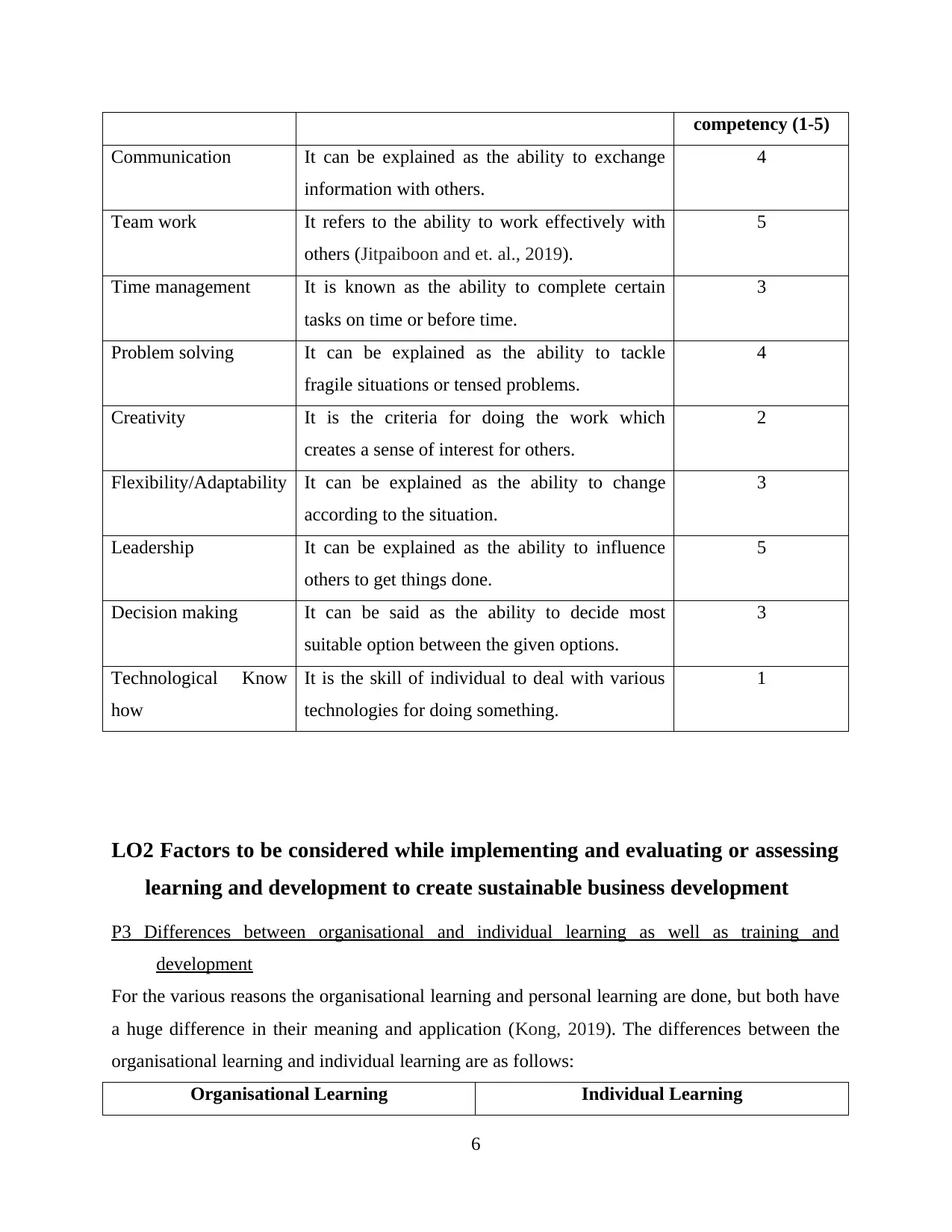
competency (1-5)
Communication It can be explained as the ability to exchange
information with others.
4
Team work It refers to the ability to work effectively with
others (Jitpaiboon and et. al., 2019).
5
Time management It is known as the ability to complete certain
tasks on time or before time.
3
Problem solving It can be explained as the ability to tackle
fragile situations or tensed problems.
4
Creativity It is the criteria for doing the work which
creates a sense of interest for others.
2
Flexibility/Adaptability It can be explained as the ability to change
according to the situation.
3
Leadership It can be explained as the ability to influence
others to get things done.
5
Decision making It can be said as the ability to decide most
suitable option between the given options.
3
Technological Know
how
It is the skill of individual to deal with various
technologies for doing something.
1
LO2 Factors to be considered while implementing and evaluating or assessing
learning and development to create sustainable business development
P3 Differences between organisational and individual learning as well as training and
development
For the various reasons the organisational learning and personal learning are done, but both have
a huge difference in their meaning and application (Kong, 2019). The differences between the
organisational learning and individual learning are as follows:
Organisational Learning Individual Learning
6
Communication It can be explained as the ability to exchange
information with others.
4
Team work It refers to the ability to work effectively with
others (Jitpaiboon and et. al., 2019).
5
Time management It is known as the ability to complete certain
tasks on time or before time.
3
Problem solving It can be explained as the ability to tackle
fragile situations or tensed problems.
4
Creativity It is the criteria for doing the work which
creates a sense of interest for others.
2
Flexibility/Adaptability It can be explained as the ability to change
according to the situation.
3
Leadership It can be explained as the ability to influence
others to get things done.
5
Decision making It can be said as the ability to decide most
suitable option between the given options.
3
Technological Know
how
It is the skill of individual to deal with various
technologies for doing something.
1
LO2 Factors to be considered while implementing and evaluating or assessing
learning and development to create sustainable business development
P3 Differences between organisational and individual learning as well as training and
development
For the various reasons the organisational learning and personal learning are done, but both have
a huge difference in their meaning and application (Kong, 2019). The differences between the
organisational learning and individual learning are as follows:
Organisational Learning Individual Learning
6
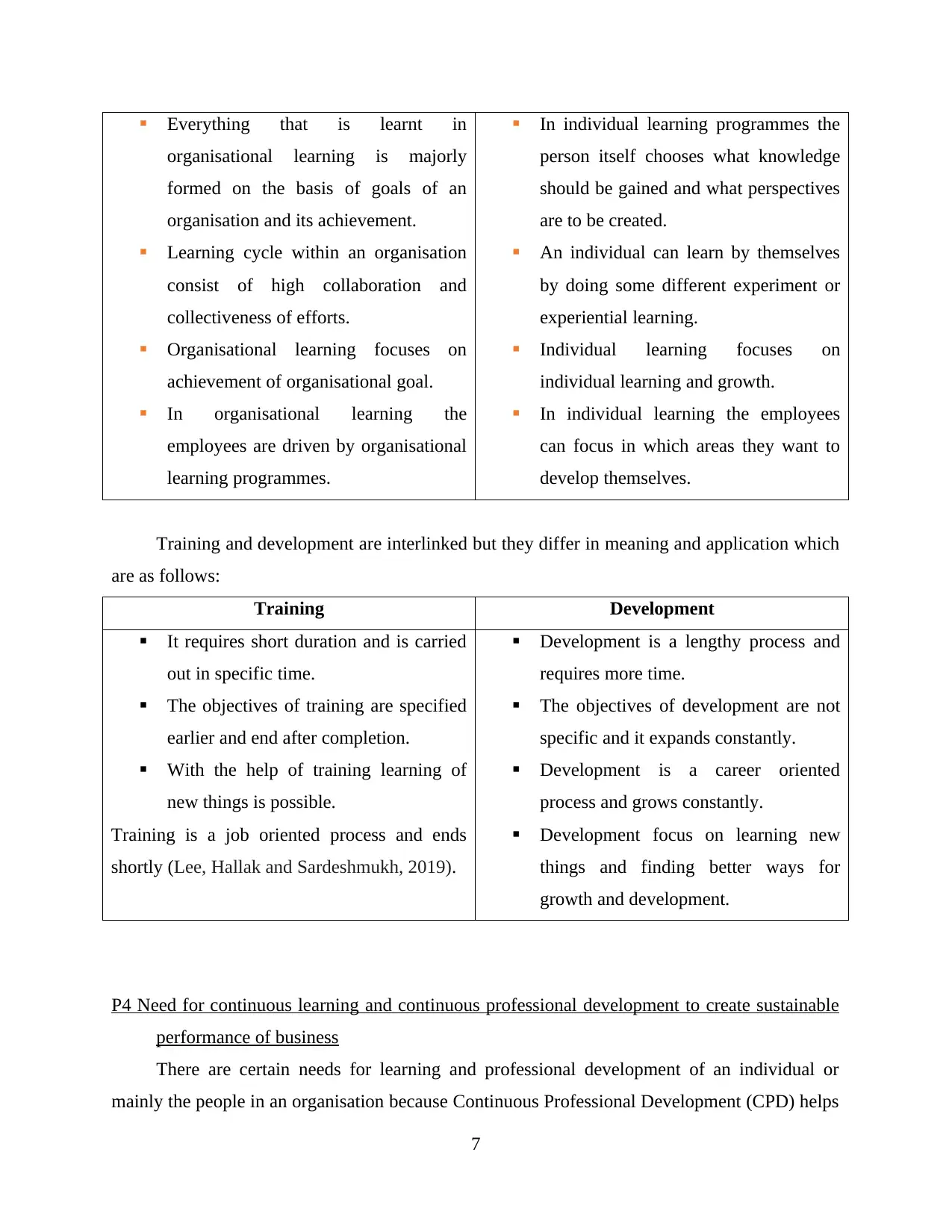
Everything that is learnt in
organisational learning is majorly
formed on the basis of goals of an
organisation and its achievement.
Learning cycle within an organisation
consist of high collaboration and
collectiveness of efforts.
Organisational learning focuses on
achievement of organisational goal.
In organisational learning the
employees are driven by organisational
learning programmes.
In individual learning programmes the
person itself chooses what knowledge
should be gained and what perspectives
are to be created.
An individual can learn by themselves
by doing some different experiment or
experiential learning.
Individual learning focuses on
individual learning and growth.
In individual learning the employees
can focus in which areas they want to
develop themselves.
Training and development are interlinked but they differ in meaning and application which
are as follows:
Training Development
It requires short duration and is carried
out in specific time.
The objectives of training are specified
earlier and end after completion.
With the help of training learning of
new things is possible.
Training is a job oriented process and ends
shortly (Lee, Hallak and Sardeshmukh, 2019).
Development is a lengthy process and
requires more time.
The objectives of development are not
specific and it expands constantly.
Development is a career oriented
process and grows constantly.
Development focus on learning new
things and finding better ways for
growth and development.
P4 Need for continuous learning and continuous professional development to create sustainable
performance of business
There are certain needs for learning and professional development of an individual or
mainly the people in an organisation because Continuous Professional Development (CPD) helps
7
organisational learning is majorly
formed on the basis of goals of an
organisation and its achievement.
Learning cycle within an organisation
consist of high collaboration and
collectiveness of efforts.
Organisational learning focuses on
achievement of organisational goal.
In organisational learning the
employees are driven by organisational
learning programmes.
In individual learning programmes the
person itself chooses what knowledge
should be gained and what perspectives
are to be created.
An individual can learn by themselves
by doing some different experiment or
experiential learning.
Individual learning focuses on
individual learning and growth.
In individual learning the employees
can focus in which areas they want to
develop themselves.
Training and development are interlinked but they differ in meaning and application which
are as follows:
Training Development
It requires short duration and is carried
out in specific time.
The objectives of training are specified
earlier and end after completion.
With the help of training learning of
new things is possible.
Training is a job oriented process and ends
shortly (Lee, Hallak and Sardeshmukh, 2019).
Development is a lengthy process and
requires more time.
The objectives of development are not
specific and it expands constantly.
Development is a career oriented
process and grows constantly.
Development focus on learning new
things and finding better ways for
growth and development.
P4 Need for continuous learning and continuous professional development to create sustainable
performance of business
There are certain needs for learning and professional development of an individual or
mainly the people in an organisation because Continuous Professional Development (CPD) helps
7
⊘ This is a preview!⊘
Do you want full access?
Subscribe today to unlock all pages.

Trusted by 1+ million students worldwide
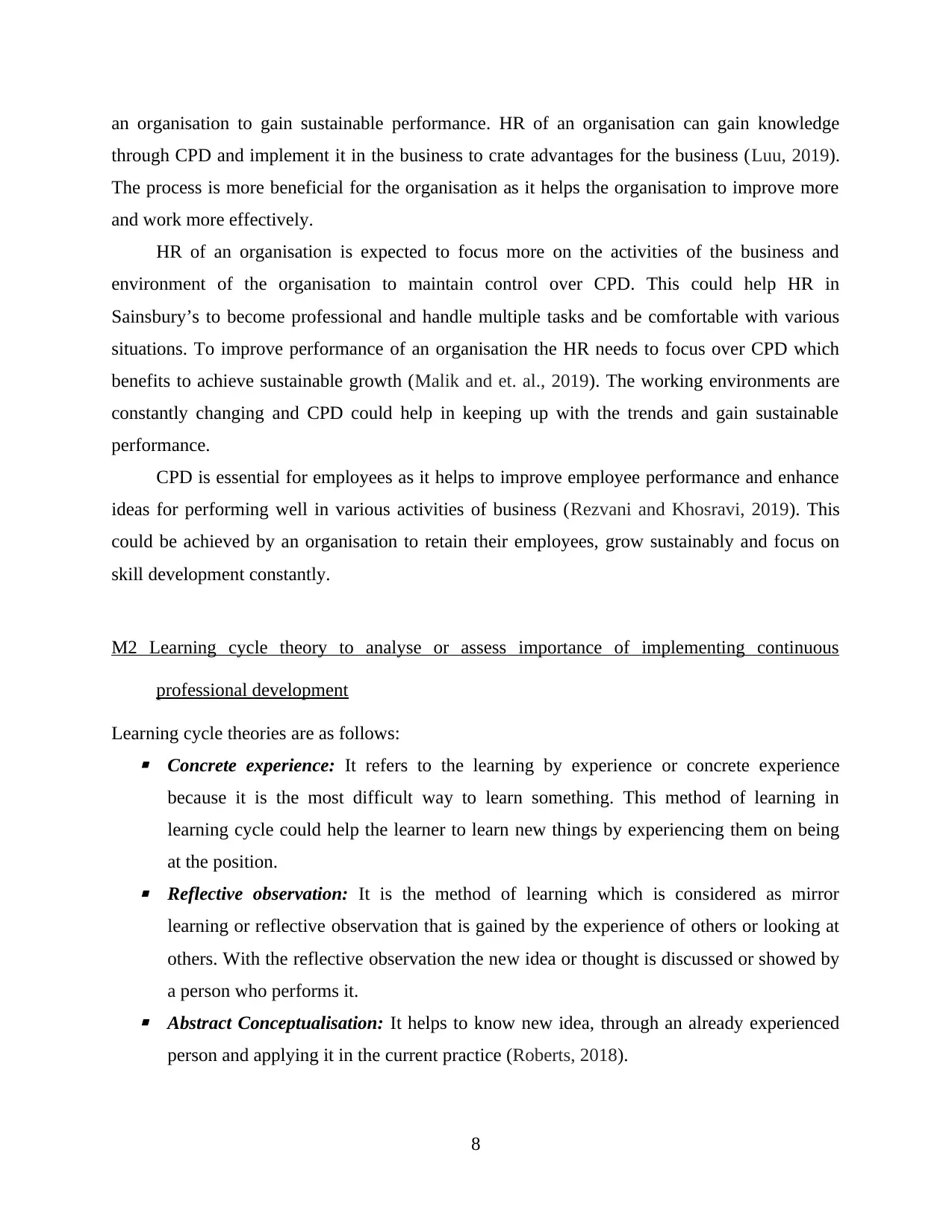
an organisation to gain sustainable performance. HR of an organisation can gain knowledge
through CPD and implement it in the business to crate advantages for the business (Luu, 2019).
The process is more beneficial for the organisation as it helps the organisation to improve more
and work more effectively.
HR of an organisation is expected to focus more on the activities of the business and
environment of the organisation to maintain control over CPD. This could help HR in
Sainsbury’s to become professional and handle multiple tasks and be comfortable with various
situations. To improve performance of an organisation the HR needs to focus over CPD which
benefits to achieve sustainable growth (Malik and et. al., 2019). The working environments are
constantly changing and CPD could help in keeping up with the trends and gain sustainable
performance.
CPD is essential for employees as it helps to improve employee performance and enhance
ideas for performing well in various activities of business (Rezvani and Khosravi, 2019). This
could be achieved by an organisation to retain their employees, grow sustainably and focus on
skill development constantly.
M2 Learning cycle theory to analyse or assess importance of implementing continuous
professional development
Learning cycle theories are as follows: Concrete experience: It refers to the learning by experience or concrete experience
because it is the most difficult way to learn something. This method of learning in
learning cycle could help the learner to learn new things by experiencing them on being
at the position. Reflective observation: It is the method of learning which is considered as mirror
learning or reflective observation that is gained by the experience of others or looking at
others. With the reflective observation the new idea or thought is discussed or showed by
a person who performs it. Abstract Conceptualisation: It helps to know new idea, through an already experienced
person and applying it in the current practice (Roberts, 2018).
8
through CPD and implement it in the business to crate advantages for the business (Luu, 2019).
The process is more beneficial for the organisation as it helps the organisation to improve more
and work more effectively.
HR of an organisation is expected to focus more on the activities of the business and
environment of the organisation to maintain control over CPD. This could help HR in
Sainsbury’s to become professional and handle multiple tasks and be comfortable with various
situations. To improve performance of an organisation the HR needs to focus over CPD which
benefits to achieve sustainable growth (Malik and et. al., 2019). The working environments are
constantly changing and CPD could help in keeping up with the trends and gain sustainable
performance.
CPD is essential for employees as it helps to improve employee performance and enhance
ideas for performing well in various activities of business (Rezvani and Khosravi, 2019). This
could be achieved by an organisation to retain their employees, grow sustainably and focus on
skill development constantly.
M2 Learning cycle theory to analyse or assess importance of implementing continuous
professional development
Learning cycle theories are as follows: Concrete experience: It refers to the learning by experience or concrete experience
because it is the most difficult way to learn something. This method of learning in
learning cycle could help the learner to learn new things by experiencing them on being
at the position. Reflective observation: It is the method of learning which is considered as mirror
learning or reflective observation that is gained by the experience of others or looking at
others. With the reflective observation the new idea or thought is discussed or showed by
a person who performs it. Abstract Conceptualisation: It helps to know new idea, through an already experienced
person and applying it in the current practice (Roberts, 2018).
8
Paraphrase This Document
Need a fresh take? Get an instant paraphrase of this document with our AI Paraphraser
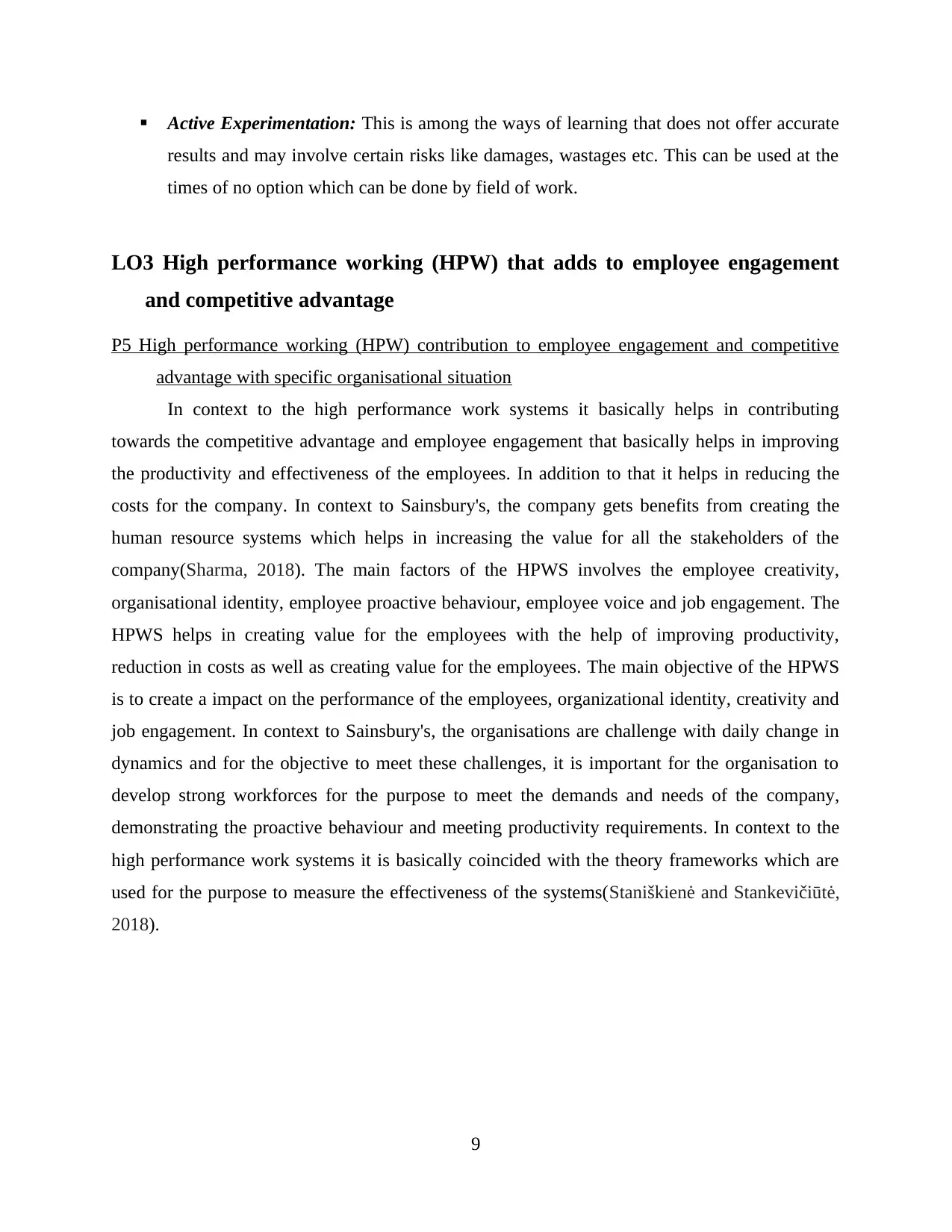
Active Experimentation: This is among the ways of learning that does not offer accurate
results and may involve certain risks like damages, wastages etc. This can be used at the
times of no option which can be done by field of work.
LO3 High performance working (HPW) that adds to employee engagement
and competitive advantage
P5 High performance working (HPW) contribution to employee engagement and competitive
advantage with specific organisational situation
In context to the high performance work systems it basically helps in contributing
towards the competitive advantage and employee engagement that basically helps in improving
the productivity and effectiveness of the employees. In addition to that it helps in reducing the
costs for the company. In context to Sainsbury's, the company gets benefits from creating the
human resource systems which helps in increasing the value for all the stakeholders of the
company(Sharma, 2018). The main factors of the HPWS involves the employee creativity,
organisational identity, employee proactive behaviour, employee voice and job engagement. The
HPWS helps in creating value for the employees with the help of improving productivity,
reduction in costs as well as creating value for the employees. The main objective of the HPWS
is to create a impact on the performance of the employees, organizational identity, creativity and
job engagement. In context to Sainsbury's, the organisations are challenge with daily change in
dynamics and for the objective to meet these challenges, it is important for the organisation to
develop strong workforces for the purpose to meet the demands and needs of the company,
demonstrating the proactive behaviour and meeting productivity requirements. In context to the
high performance work systems it is basically coincided with the theory frameworks which are
used for the purpose to measure the effectiveness of the systems(Staniškienė and Stankevičiūtė,
2018).
9
results and may involve certain risks like damages, wastages etc. This can be used at the
times of no option which can be done by field of work.
LO3 High performance working (HPW) that adds to employee engagement
and competitive advantage
P5 High performance working (HPW) contribution to employee engagement and competitive
advantage with specific organisational situation
In context to the high performance work systems it basically helps in contributing
towards the competitive advantage and employee engagement that basically helps in improving
the productivity and effectiveness of the employees. In addition to that it helps in reducing the
costs for the company. In context to Sainsbury's, the company gets benefits from creating the
human resource systems which helps in increasing the value for all the stakeholders of the
company(Sharma, 2018). The main factors of the HPWS involves the employee creativity,
organisational identity, employee proactive behaviour, employee voice and job engagement. The
HPWS helps in creating value for the employees with the help of improving productivity,
reduction in costs as well as creating value for the employees. The main objective of the HPWS
is to create a impact on the performance of the employees, organizational identity, creativity and
job engagement. In context to Sainsbury's, the organisations are challenge with daily change in
dynamics and for the objective to meet these challenges, it is important for the organisation to
develop strong workforces for the purpose to meet the demands and needs of the company,
demonstrating the proactive behaviour and meeting productivity requirements. In context to the
high performance work systems it is basically coincided with the theory frameworks which are
used for the purpose to measure the effectiveness of the systems(Staniškienė and Stankevičiūtė,
2018).
9
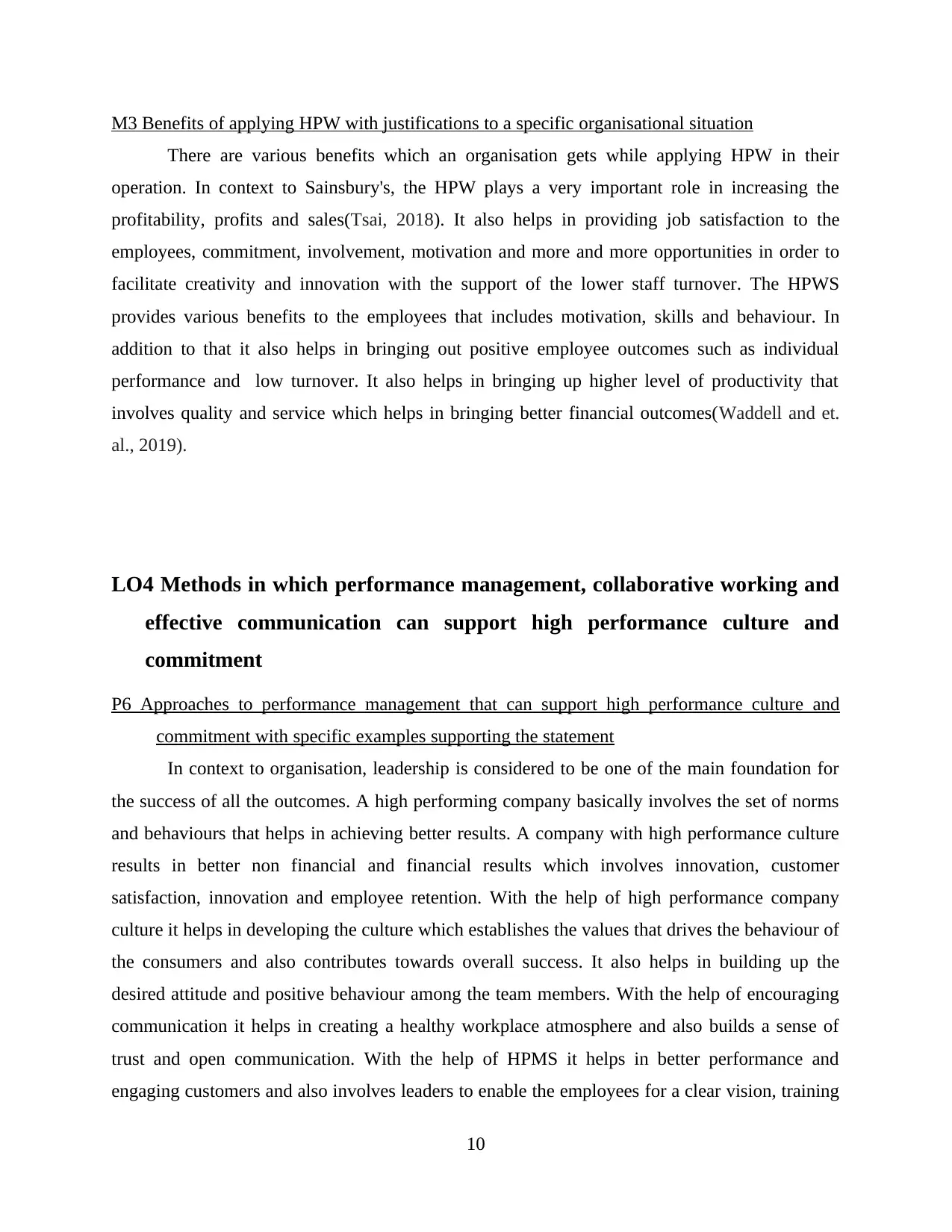
M3 Benefits of applying HPW with justifications to a specific organisational situation
There are various benefits which an organisation gets while applying HPW in their
operation. In context to Sainsbury's, the HPW plays a very important role in increasing the
profitability, profits and sales(Tsai, 2018). It also helps in providing job satisfaction to the
employees, commitment, involvement, motivation and more and more opportunities in order to
facilitate creativity and innovation with the support of the lower staff turnover. The HPWS
provides various benefits to the employees that includes motivation, skills and behaviour. In
addition to that it also helps in bringing out positive employee outcomes such as individual
performance and low turnover. It also helps in bringing up higher level of productivity that
involves quality and service which helps in bringing better financial outcomes(Waddell and et.
al., 2019).
LO4 Methods in which performance management, collaborative working and
effective communication can support high performance culture and
commitment
P6 Approaches to performance management that can support high performance culture and
commitment with specific examples supporting the statement
In context to organisation, leadership is considered to be one of the main foundation for
the success of all the outcomes. A high performing company basically involves the set of norms
and behaviours that helps in achieving better results. A company with high performance culture
results in better non financial and financial results which involves innovation, customer
satisfaction, innovation and employee retention. With the help of high performance company
culture it helps in developing the culture which establishes the values that drives the behaviour of
the consumers and also contributes towards overall success. It also helps in building up the
desired attitude and positive behaviour among the team members. With the help of encouraging
communication it helps in creating a healthy workplace atmosphere and also builds a sense of
trust and open communication. With the help of HPMS it helps in better performance and
engaging customers and also involves leaders to enable the employees for a clear vision, training
10
There are various benefits which an organisation gets while applying HPW in their
operation. In context to Sainsbury's, the HPW plays a very important role in increasing the
profitability, profits and sales(Tsai, 2018). It also helps in providing job satisfaction to the
employees, commitment, involvement, motivation and more and more opportunities in order to
facilitate creativity and innovation with the support of the lower staff turnover. The HPWS
provides various benefits to the employees that includes motivation, skills and behaviour. In
addition to that it also helps in bringing out positive employee outcomes such as individual
performance and low turnover. It also helps in bringing up higher level of productivity that
involves quality and service which helps in bringing better financial outcomes(Waddell and et.
al., 2019).
LO4 Methods in which performance management, collaborative working and
effective communication can support high performance culture and
commitment
P6 Approaches to performance management that can support high performance culture and
commitment with specific examples supporting the statement
In context to organisation, leadership is considered to be one of the main foundation for
the success of all the outcomes. A high performing company basically involves the set of norms
and behaviours that helps in achieving better results. A company with high performance culture
results in better non financial and financial results which involves innovation, customer
satisfaction, innovation and employee retention. With the help of high performance company
culture it helps in developing the culture which establishes the values that drives the behaviour of
the consumers and also contributes towards overall success. It also helps in building up the
desired attitude and positive behaviour among the team members. With the help of encouraging
communication it helps in creating a healthy workplace atmosphere and also builds a sense of
trust and open communication. With the help of HPMS it helps in better performance and
engaging customers and also involves leaders to enable the employees for a clear vision, training
10
⊘ This is a preview!⊘
Do you want full access?
Subscribe today to unlock all pages.

Trusted by 1+ million students worldwide
1 out of 17
Related Documents
Your All-in-One AI-Powered Toolkit for Academic Success.
+13062052269
info@desklib.com
Available 24*7 on WhatsApp / Email
![[object Object]](/_next/static/media/star-bottom.7253800d.svg)
Unlock your academic potential
Copyright © 2020–2025 A2Z Services. All Rights Reserved. Developed and managed by ZUCOL.
